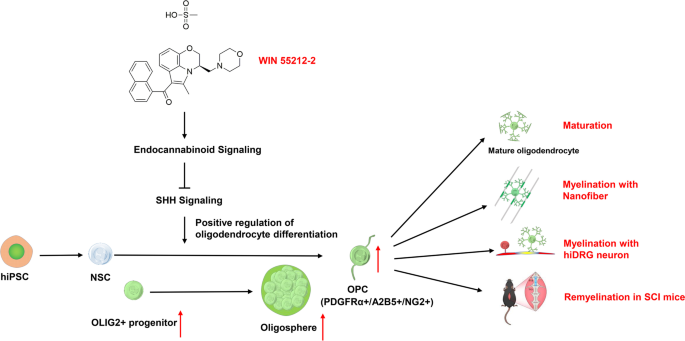
“Transplantation of oligodendrocyte progenitor cell (OPC) at the injury site is being developed as a potential therapeutic strategy for promoting remyelination and locomotor function recovery after spinal cord injury (SCI). To this end, the development of expandable and functional human OPCs is crucial for testing their efficacy in SCI.
In mice and rats, the endocannabinoid signaling system is crucial for the survival, differentiation, and maturation of OPCs. Similar studies in humans are lacking currently. Endocannabinoids and exogenous cannabinoids exert their effects mainly via cannabinoid receptors (CB1R and CB2R). We demonstrated that these receptors were differentially expressed in iPSC-derived human NSCs and OPCs, and they could be activated by WIN55212-2 (WIN), a potent CB1R/CB2R agonist to upregulate the endocannabinoid signaling during glial induction.
WIN primed NSCs generated more OLIG2 + glial progenitors and migratory PDGFRα + OPC in a CB1/CB2 dependent manner compared to unprimed NSCs. Furthermore, WIN-induced OPCs (WIN-OPCs) robustly differentiated into functional oligodendrocytes and myelinate in vitro and in vivo in a mouse spinal cord injury model. RNA-Seq revealed that WIN upregulated the biological process of positive regulation of oligodendrocyte differentiation. Mechanistically, WIN could act as a partial smoothed (SMO) inhibitor or activate CB1/CB2 to form heteromeric complexes with SMO leading to the inhibition of GLI1 in the Sonic hedgehog pathway.
The partial and temporal inhibition of GLI1 during glial induction is shown to promote OPCs that differentiate faster than control’s. Thus, CB1R/CB2R activation results in more efficient generation of OPCs that can mature and efficiently myelinate.”
https://pubmed.ncbi.nlm.nih.gov/35725998/
https://link.springer.com/article/10.1007/s12015-022-10405-0









